Plasma cell ontogeny defined by quantitative changes in blimp-1 expression
- PMID: 15492122
- PMCID: PMC2211847
- DOI: 10.1084/jem.20040973
Plasma cell ontogeny defined by quantitative changes in blimp-1 expression
Abstract
Plasma cells comprise a population of terminally differentiated B cells that are dependent on the transcriptional regulator B lymphocyte--induced maturation protein 1 (Blimp-1) for their development. We have introduced a gfp reporter into the Blimp-1 locus and shown that heterozygous mice express the green fluorescent protein in all antibody-secreting cells (ASCs) in vivo and in vitro. In vitro, these cells display considerable heterogeneity in surface phenotype, immunoglobulin secretion rate, and Blimp-1 expression levels. Importantly, analysis of in vivo ASCs induced by immunization reveals a developmental pathway in which increasing levels of Blimp-1 expression define developmental stages of plasma cell differentiation that have many phenotypic and molecular correlates. Thus, maturation from transient plasmablast to long-lived ASCs in bone marrow is predicated on quantitative increases in Blimp-1 expression.
Figures
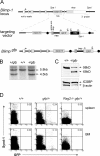
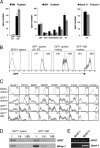
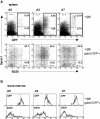


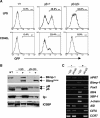
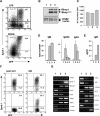

References
-
- Manz, R.A., S. Arce, G. Cassese, A.E. Hauser, F. Hiepe, and A. Radbruch. 2002. Humoral immunity and long-lived plasma cells. Curr. Opin. Immunol. 14:517–521. - PubMed
-
- Manz, R.A., M. Lohning, G. Cassese, A. Thiel, and A. Radbruch. 1998. Survival of long-lived plasma cells is independent of antigen. Int. Immunol. 10:1703–1711. - PubMed
-
- Angelin-Duclos, C., G. Cattoretti, K.I. Lin, and K. Calame. 2000. Commitment of B lymphocytes to a plasma cell fate is associated with Blimp-1 expression in vivo. J. Immunol. 165:5462–5471. - PubMed
-
- Turner, C.A., Jr., D.H. Mack, and M.M. Davis. 1994. Blimp-1, a novel zinc finger-containing protein that can drive the maturation of B lymphocytes into immunoglobulin-secreting cells. Cell. 77:297–306. - PubMed
-
- Schliephake, D.E., and A. Schimpl. 1996. Blimp-1 overcomes the block in IgM secretion in lipopolysaccharide/anti-mu F(ab′)2-co-stimulated B lymphocytes. Eur. J. Immunol. 26:268–271. - PubMed
Publication types
MeSH terms
Substances
LinkOut - more resources
Full Text Sources
Other Literature Sources
Molecular Biology Databases
Research Materials

